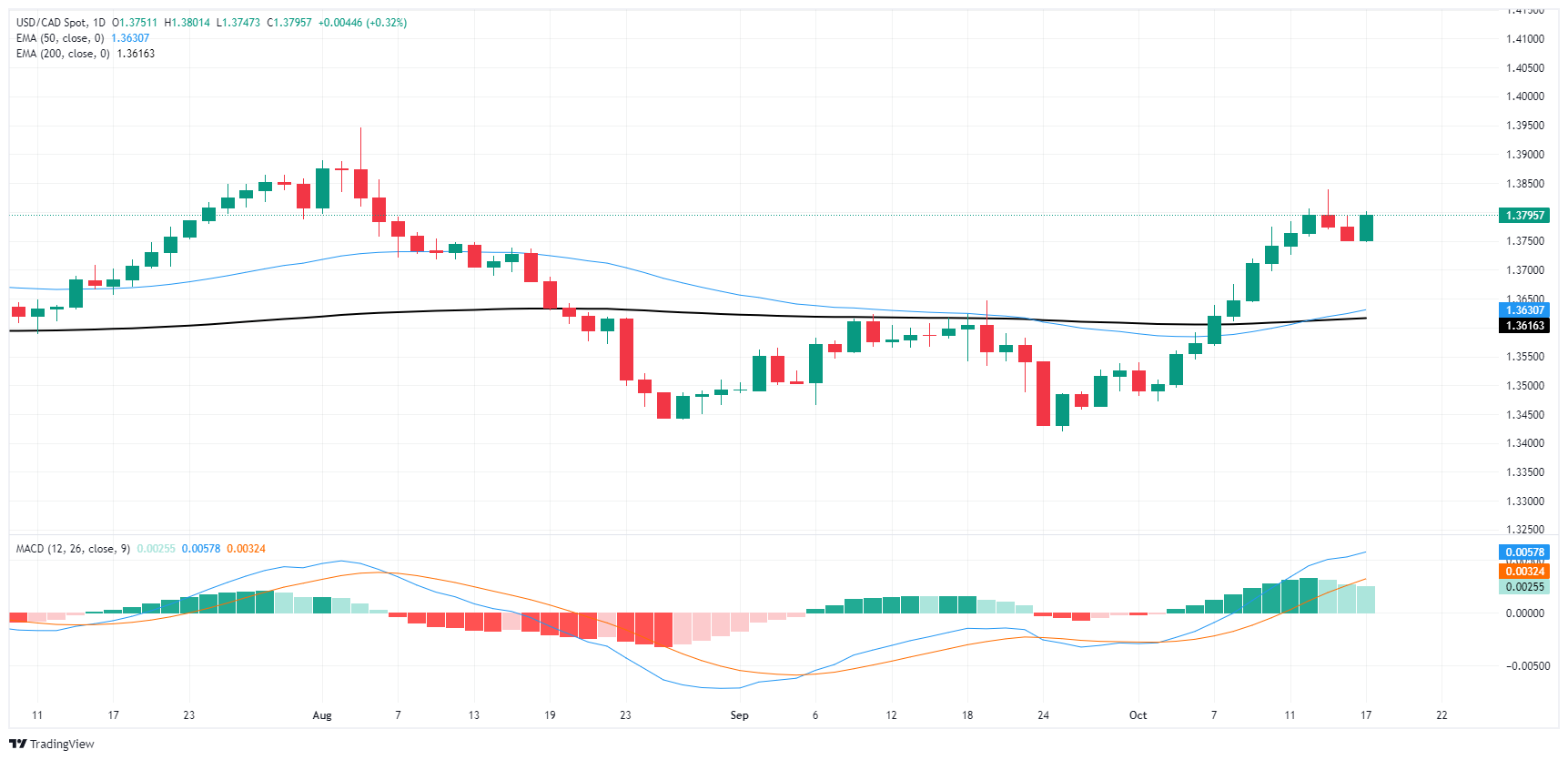Canadian Dollar ends recovery run as quickly as it began
- The Canadian Dollar backslid once again on Thursday.
- Canada lacks meaningful data releases this week.
- The BoC is broadly expected to ease rates further, limiting CAD strength.
The Canadian Dollar (CAD) snapped its recent recovery, falling back into the low end on Thursday, driven lower by an overall upbeat market tone toward the Greenback. Making matters worse, the Loonie is suffering from a lack of key support with the Bank of Canada (BoC) broadly expected to trim interest rates by a further 50 bps.
Daily digest market movers
- The CAD’s recovery rally snapped almost as soon as it started.
- The Loonie shed one-third of one percent against the Greenback after a meager recovery following a ten-day decline.
- US Retail Sales firmly beat expectations for September, bolstering the US Dollar heading into the tail end of the trading week.
- US Initial Jobless Claims also beat the street on Thursday, further propping up Greenback bidding flows.
- Most analysts expect the BoC to trim interest rates by another 50 bps on October 23 to try to bolster a swamped-out housing market being crushed by a national housing affordability crisis.
Canadian Dollar price forecast
The USD/CAD pair has shown a robust bullish movement recently, with the price breaking above the 50-day Exponential Moving Average (EMA), which is currently at 1.3631, and trading above the 200-day EMA at 1.3615. The pair has found short-term resistance near the 1.3800 psychological level, after testing highs around 1.3801. However, it has yet to confirm a breakout above this level. The sustained bullish momentum is also supported by the upward slope of the 50-day EMA, which is approaching a bullish crossover with the 200-day EMA, suggesting further upside potential if the price can clear the immediate resistance.
The Moving Average Convergence Divergence (MACD) indicator shows continued bullish momentum, with the MACD line trading above the signal line and remaining in positive territory. However, the histogram is beginning to flatten, indicating a potential slowdown in upward momentum in the short term. Should the pair fail to break above 1.3800 convincingly, we may see a pullback toward the 50-day EMA support around 1.3631. A sustained move above 1.3800 would open the door for further gains toward the next resistance levels at 1.3850 and 1.3900.
USD/CAD daily chart
Canadian Dollar FAQs
The key factors driving the Canadian Dollar (CAD) are the level of interest rates set by the Bank of Canada (BoC), the price of Oil, Canada’s largest export, the health of its economy, inflation and the Trade Balance, which is the difference between the value of Canada’s exports versus its imports. Other factors include market sentiment – whether investors are taking on more risky assets (risk-on) or seeking safe-havens (risk-off) – with risk-on being CAD-positive. As its largest trading partner, the health of the US economy is also a key factor influencing the Canadian Dollar.
The Bank of Canada (BoC) has a significant influence on the Canadian Dollar by setting the level of interest rates that banks can lend to one another. This influences the level of interest rates for everyone. The main goal of the BoC is to maintain inflation at 1-3% by adjusting interest rates up or down. Relatively higher interest rates tend to be positive for the CAD. The Bank of Canada can also use quantitative easing and tightening to influence credit conditions, with the former CAD-negative and the latter CAD-positive.
The price of Oil is a key factor impacting the value of the Canadian Dollar. Petroleum is Canada’s biggest export, so Oil price tends to have an immediate impact on the CAD value. Generally, if Oil price rises CAD also goes up, as aggregate demand for the currency increases. The opposite is the case if the price of Oil falls. Higher Oil prices also tend to result in a greater likelihood of a positive Trade Balance, which is also supportive of the CAD.
While inflation had always traditionally been thought of as a negative factor for a currency since it lowers the value of money, the opposite has actually been the case in modern times with the relaxation of cross-border capital controls. Higher inflation tends to lead central banks to put up interest rates which attracts more capital inflows from global investors seeking a lucrative place to keep their money. This increases demand for the local currency, which in Canada’s case is the Canadian Dollar.
Macroeconomic data releases gauge the health of the economy and can have an impact on the Canadian Dollar. Indicators such as GDP, Manufacturing and Services PMIs, employment, and consumer sentiment surveys can all influence the direction of the CAD. A strong economy is good for the Canadian Dollar. Not only does it attract more foreign investment but it may encourage the Bank of Canada to put up interest rates, leading to a stronger currency. If economic data is weak, however, the CAD is likely to fall.
